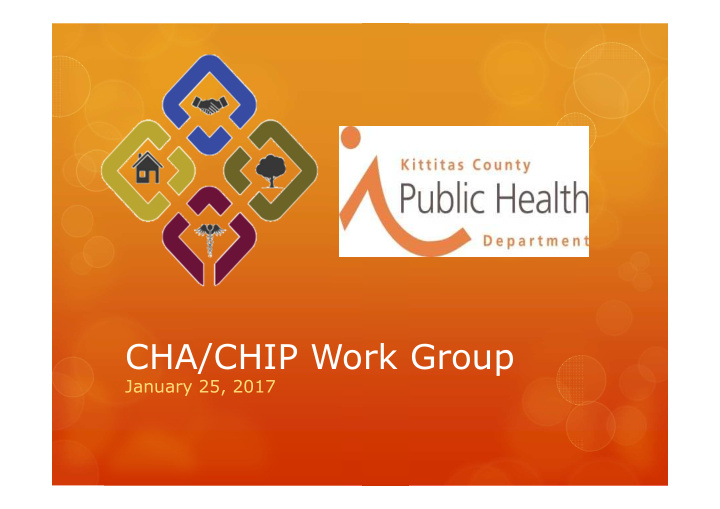



CHA/CHIP Work Group January 25, 2017
Today’s Meeting Outcomes 1. Participants will understand the relationship between the CHA/CHIP work and the Kittitas County Health Network. 2. Participants will understand the relevance of the previous CHIP to existing and current efforts. 3. Participants will understand the alignment or lack of alignment with regional, state, and national priorities. 4. Participants will discuss and analyze draft strategic issues.
Population Health Kittitas County Systems Cross-Sector Collaboration Health Network Change Steering Committee/ Board of Care CHA/CHIP Directors Coordination Work Group Work Group (Strategic (A-Team) Planning) Leadership Council/ Advisory Work Group
2013-2017 Kittitas County CHIP Strategic Issue How can we strengthen COORDINATION AND COMMUNICATION among local public health system partners? � Lack of community mobilization around health issues � Continue to foster collaborations formed during CHA/CHIP process Goal: Partners will have clear methods identified and utilized for connecting, collaborating, coordinating, and communicating with each other on a regular basis. Strategies: � Establish structure for convening and collaborating on community health improvement � Promote local community resources among each other. � Increase participation in annual KVH health fair.
2013-2017 Kittitas County CHIP Strategic Issue How can we work effectively together to improve the QUALITY AND � AFFORDABILITY OF HEALTH CARE? � Health care reform � Community dissatisfaction with local health care quality � Inability to pay for needed care Goal: Residents have access to high quality, respectful, inclusive, and affordable health care. Residents will also have the information and support necessary to access health care. Strategies: � Promote local community resources among the general public and populations with barriers to accessing resources. � Increase health literacy and improve patient/provider communication. � Connect patients with medical homes. � Promote currently underutilized resources.
2013-2017 Kittitas County CHIP Strategic Issue How can we increase utilization of and access to PREVENTIVE CARE � and support HEALTHY BEHAVIORS? How can we improve knowledge and capacity to MANAGE STRESS IN A HEALTHY WAY? � Stress as underlying cause of preventable health conditions � Familial stress identified as significant issue � Health behaviors important for a health community Goal: Residents have access to and support in utilizing resources to engage in preventive care and healthy behaviors. Residents will also have knowledge, capacity, and support to manage stress through healthy behaviors. Strategies: � Promote local community resources among the general public and populations with barriers to accessing resources. � Establish paid position dedicated to helping people access resources � Work with employers on supporting employee health and wellness.
Greater Columbia Accountable Community of Health Strategic Issues 1. Foster cross sector collaboration 2. Build healthier, more equitable communities 3. Strengthen the integration of health services and systems
Greater Columbia Accountable Community of Health Strategies 1. Community capacity for collaborations 2. Community based physical activity programs 3. Behavioral health with clinical-community linkages 4. Diabetes/obesity programs with clinical-community linkages 5. Oral health with clinical-community linkages 6. Integrated health education programs 7. Care coordination with clinical-community linkages
2014-2018 State Health Improvement Plan Near Term Impact � Nutrition, Physical Activity, Obesity � Physical activity, healthier food choices, breastfeeding and child nutrition � Access to care and the Affordable Care Act � ACH support Long Term Shift � Invest in the health and well being of our youngest children and families � Support development of healthy neighborhoods and communities � Broaden health care to promote health outside the medical system
Robert Wood Johnson Foundation Culture of Health Action Framework 1. How can individuals, families, and communities work to achieve and maintain health? 2. How can we encourage cooperation across all sectors? 3. How can we develop safe environments that nurture children, support aging adults, and offer equitable access to healthy choices? 4. How can health care providers work with institutional partners to address the realities of patients lives?
Recommend
More recommend